Home » Learn » Articles on Acoustics » Restaurant Acoustics
Noise in restaurants is a well-known problem. In a crowded restaurant, the noise from speech can sometimes be such a nuisance that the visit becomes a bad experience. Especially for a hard-of-hearing person, restaurant noise can make it impossible to follow a conversation. The problem is also known from cafeterias, banquets, and other kinds of social gatherings in rooms with insufficient sound absorption. So, restaurant acoustics should be considered as much as the more visual aspects.
Noise is one of the most common reasons for complaints, and today we can often see restaurant reviews that include a noise rating in addition the rating of quality of food and service. The “Café and Restaurant Acoustic Index” (CRAI) was introduced many years ago in New Zealand, using a five star rating:
★ Lip-reading would be an advantage.
★★ Take earplugs at the very least.
★★★ Not too bad, particularly mid-week.
★★★★ A nice quiet evening.
★★★★★ The place to be and be heard.
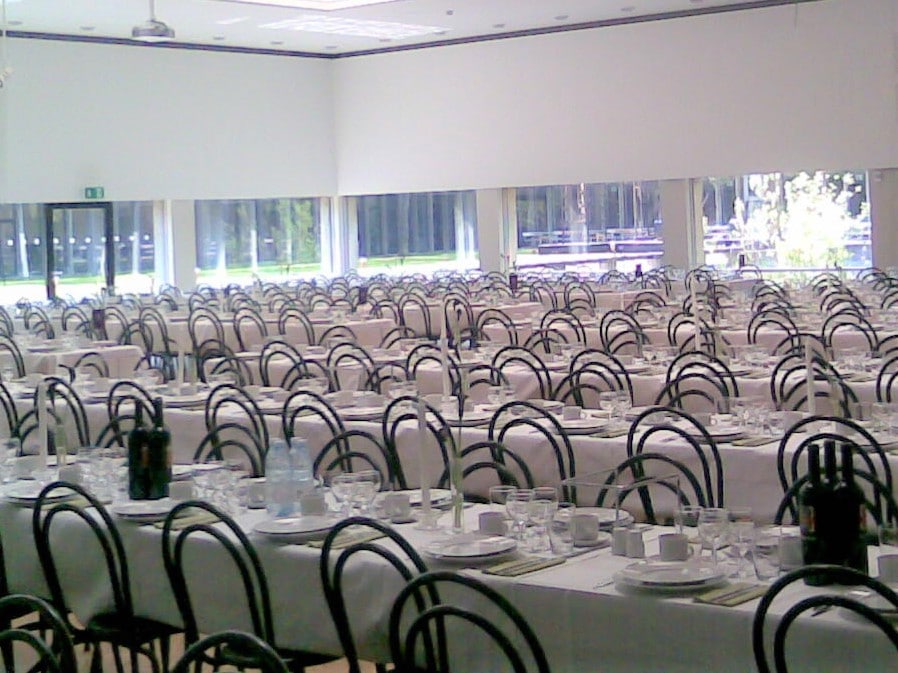
The American Zagat survey collects ratings of restaurants by diners. In Zagat’s 2016 Annual Survey, when surveyors were asked what irritated them the most about dining out, noise was the second highest complaint (25%) behind poor service (28%). But in major urban cities of San Francisco, Boston, Portland and New York City, noise was the number one complaint.
For restaurant owners it may be interesting to know that noise has an impact on food perception. The theory is that noise disrupts taste and smell, and it is found that the food tastes less intense in loud noise (75 dB to 85 dB).
The main parameters that determine the restaurant noise level are the volume of the room, reverberation time, and the number of people.
Listening to voices at a social gathering is a very interesting situation that challenges our hearing system. Due to the ability of a normal hearing person to localize a sound source in the surrounding 3D space, it is possible to focus on one out of many voices, and to catch what one person says, while the other voices are suppressed as background noise. This is the so-called “cocktail party effect”. However, this ability requires normal hearing with both ears. People with reduced hearing capability and people using hearing aids of older types may not be able to separate the voices in the 3D space.
The dynamic range of the human voice is remarkable. The vocal effort is characterized by the A-weighted SPL 1 meter in front of the speaker. Normal vocal effort corresponds to an SPL around 60 dB at a distance of 1 meter. By shouting, the SPL can reach 90 dB or more, whereas in private communication (whispering or soft speech) typical levels are below 45 dB. The vocal effort depends on the situation, the distance to the people being addressed, but also the character of the talk, e.g. private conversation, or giving a message.
In a noisy gathering, everyone raises their own voice in order to be heard better, which again leads to a higher ambient noise level. This unconscious raising of the voice in a noisy environment is called the Lombard effect, which is a common phenomenon in restaurant acoustics. In quiet surroundings, the vocal effort is not influenced by the ambient noise, but if the noise level exceeds 45 dB it starts to influence the speech level. Interestingly enough, the Lombard effect is not particular to humans, but has also been found in other mammals and birds.

The average relationship between speech level and ambient noise level is shown in the graph below. The slope of the curve is 0,5 dB/dB. Thus, if the ambient noise is increased by 6 dB, the vocal effort is expected to increase by 3 dB. The steps of vocal effort from relaxed to shouting are labelled in the figure.
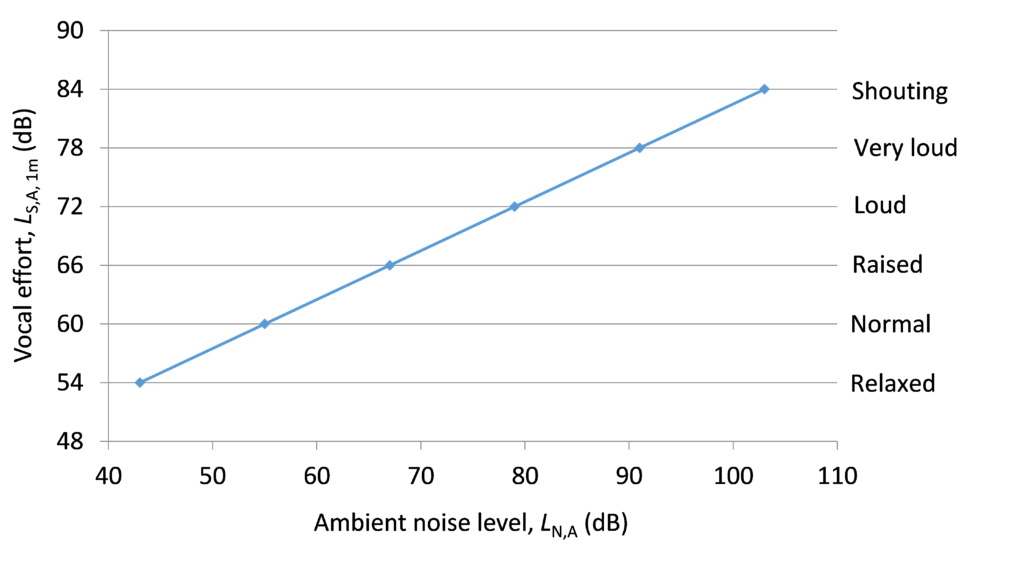
When enjoying a good meal in a restaurant and having a private conversation, the ambient restaurant noise (including background music) should not exceed 55 dB, as this corresponds to normal vocal effort. However, in a busy cafeteria, the ambient noise can typically reach 70 to 80 dB, and a conversation is only possible in a loud or very loud voice.
The ambient noise in a room due to many people speaking simultaneously can be predicted by taking the Lombard effect into account. The result is that the noise decreases by 6 dB if the number of speaking persons is halved or if the reverberation time is halved. This may be a little surprising, because we normally have only 3 dB reduction of the noise if the reverberation time is halved. So, adding more sound absorption to the room surfaces is quite efficient; doubling the absorption area will also lead to a 6 dB reduction of the ambient noise level with the same number of speaking persons. It has also been found that, in restaurants and banquet halls, the average number of speaking people is the total number of people divided by 3,5 (as per this publication on restaurant acoustics). You could say that the average group size around each speaking person is between 3 and 4 people.
In the figure below, the red curve shows the ambient noise due to speech as a function of the absorption area divided by the number of speaking people. Knowing the ambient noise level, it is also possible to estimate the average vocal effort that creates this noise level, and this is shown as the dotted curve.

When listening to a conversation, the SPL of the voice should preferably exceed the SPL of the ambient noise. The difference between these two SPLs is called the signal-to-noise ratio (SNR). If the absorption area per speaking person is 25 m2, the SPL is 65 dB both for the ambient noise level and for the speech level at a distance of 1 meter. Thus SNR = 0 dB.
For normal-hearing people, it may be sufficient to have SNR = -3 dB, but in other cases this will be clearly insufficient, namely in case of elderly people with reduced hearing capability or in case of a conversation in a foreign language.
From the graphs in the above figure, we see that SNR = -3 dB corresponds to an ambient noise level of 71 dB. In order to obtain an SNR = -3, the absorption area should be 12,5 m2 per speaking person or approximately 3,5 m2 times the total number of persons. If this minimum of absorption cannot be established, the acoustics must be characterized as insufficient, and the total number of people in the facility should be reduced.
The fact that restaurant noise depends strongly on the number of people present, has led to the concept called ‘Acoustic capacity’. This is defined as “the maximum number of people allowed in a room for ‘Sufficient’ quality of verbal communication” (as per this publication). Thus, the acoustic capacity is the number of people that can be expected to create a SNR = -3 dB at a distance of 1 meter, and the corresponding ambient noise level of 71 dB. The acoustic capacity of a space depends on the volume V (m3) and the reverberation time T (s):

This shows that there are two ways to increase the restaurant’s acoustic capacity. Either the volume should be enlarged, e.g. by opening to adjacent spaces, or the reverberation time should be decreased by adding sound absorbing material to the surfaces.
The graph below shows the ambient noise level as function of the occupancy relative to the acoustic capacity. The figure also shows the SNR at a 1 meter distance and the corresponding quality of verbal communication.

The photo below shows an example of a banquet hall that seems to be too crowded and with insufficient volume.
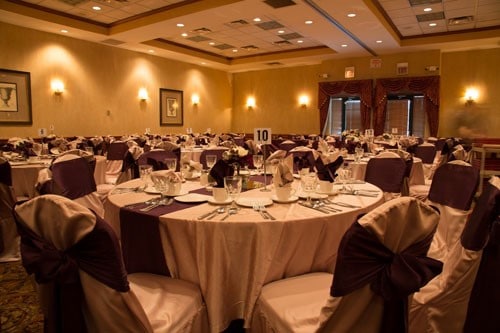
Another example is shown in the plan drawing below. This is a multi-purpose hall with high ceiling (17 m). The volume is 12 920 m3 and the reverberation time is 1,5 s.
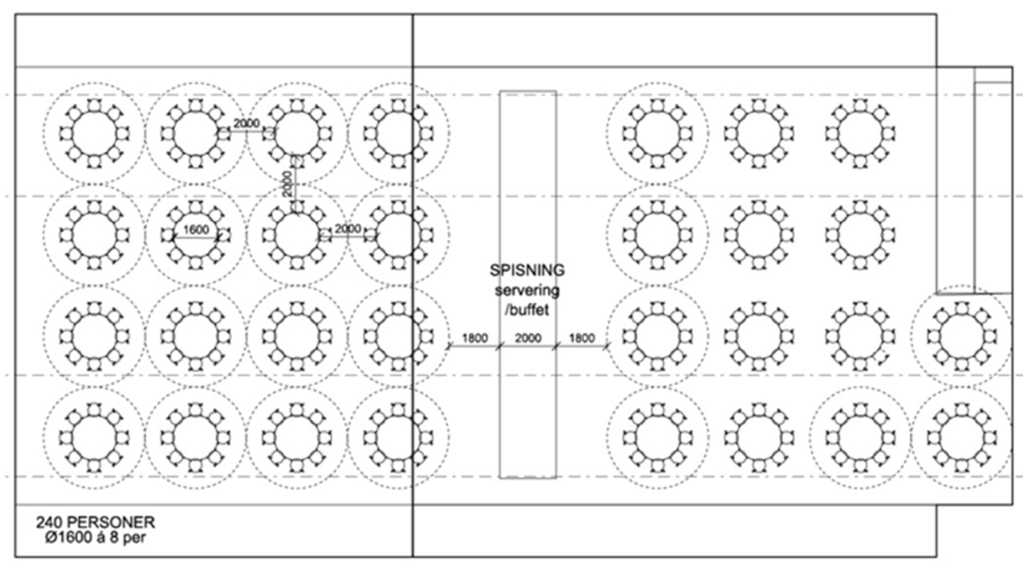
The figure shows the set-up for banquet for 240 people. The round tables are 1,6 m in diameter and seat eight people each. Because of the high ceiling, there is sufficient volume per person. The acoustic capacity is 430. With 240 persons the estimated ambient noise level is 66 dB and the SNR at 1 meter distance is -1 dB, which suggests ‘sufficient’ quality of verbal communication.
In practice, it is often difficult to estimate the volume of an eating facility, especially when it is connected to other spaces, as in food courts or hotels with a lobby, or an atrium in open connection with the restaurant. In such cases it can be relevant to make a simulation of the restaurant acoustics in ODEON. For this purpose, a method is developed that uses a surface source with a typical speech spectrum, see the application note for further details.
The photo below shows the case of a dinner party in a university. The volume is 1605 m3 and the reverberation time with tables and chairs, but without people, is 1,0 second. The number of people attending the dinner in this room was 380, whereas the acoustic capacity is found to be only 82.
The sound level was monitored during the evening, and it was quite stable for about two hours. The measured average SPL was 82,9 dB which corresponds to SNR = -9 dB and very bad quality of verbal communication.
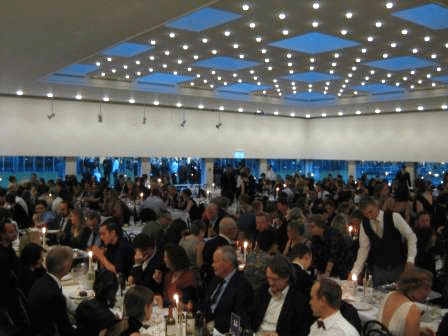
The model used for the ODEON simulation is shown below. The calculation result using the spectrum of loud speech was an ambient noise level with SPL = 83,1 dB, which is an almost perfect match with the measurement result.

The auralisation tool of ODEON may be used to demonstrate the quality of verbal communication with different restaurant acoustic conditions, particularly by looking at the signal-to-noise ratio (SNR). Try listening to the auralisation examples below. For the details about how to do this, see the application note.
Quality of verbal
communication
SNR [dB]
Vocal effort LS,A,1m [dB]
Ambient noise LN,A [dB]
Auralisation
Very good
Quality of verbal communication:
Very good – Good
SNR [dB]: 9
9
Vocal effort LS,A,1m [dB]: 56
56
Ambient noise LN,A [dB]: 47
47
Auralisation:
Good
Quality of verbal communication:
Good – Satisfactory
SNR [dB]: 3
3
Vocal effort LS,A,1m [dB]: 62
62
Ambient noise LN,A [dB]: 59
59
Auralisation:
Satisfactory
Quality of verbal communication:
Satisfactory – Sufficient
SNR [dB]: 0
0
Vocal effort LS,A,1m [dB]: 65
65
Ambient noise LN,A [dB]: 65
65
Auralisation:
Sufficient
Quality of verbal communication:
Sufficient – Insufficient
SNR [dB]: -3
-3
Vocal effort LS,A,1m [dB]: 68
68
Ambient noise LN,A [dB]: 71
71
Auralisation:
Insufficient
Quality of verbal communication:
Insufficient – Very bad
SNR [dB]: -9
-9
Vocal effort LS,A,1m [dB]: 74
74
Ambient noise LN,A [dB]: 83
83
Auralisation:
Very bad
Copyright © 2024 Odeon A/S
DTU Science Park, Diplomvej Bldg. 381
DK-2800 Kgs. Lyngby, Denmark
Tlf: +45 8870 8845
CVR No. DK 26391253
info@odeon.dk
Feel free to contact us for any question you may have! We will do our best to answer as soon as possible!
We can even set up a Skype demonstration before a potential purchase.
Would you like to receive important news regarding updates, courses etc. 3 – 5 times a year? Sign-up below!
Feel free to contact us for any question you may have! We will do our best to answer as soon as possible!
We can even set up a Skype demonstration before a potential purchase.
Please notice that you are contacting Odeon Room Acoustic Software company, which is not related to any other businesses that use the same name (Odeon cinemas, Odeon in Odense etc.).
Unfortunately we receive a lot of false inquiries lately. These will be deleted immediately in our account. Thank you for your understanding.
Please share your location to continue.
Check our help guide for more info.
